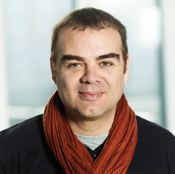Professor Guillermo Montoya joins CPR
 Novo Nordisk Foundation Center for Protein Research (CPR) is pleased to announce that we have appointed Professor Guillermo Montoya as Research Director of the newly established Protein Structure Program at the Center.
Novo Nordisk Foundation Center for Protein Research (CPR) is pleased to announce that we have appointed Professor Guillermo Montoya as Research Director of the newly established Protein Structure Program at the Center.
Prof. Montoya joins CPR from a position as Senior Group Leader at the Spanish National Cancer Research Centre (CNIO) in Madrid, where he has been employed since 2002.
CPR was established in 2007 with the mission to combine cutting edge protein-based technologies with biological and biomedical applications. The center is now fully established and ready to expand its research activities, and Prof. Montoya was identified as the absolute top candidate to lead a new Program focused on structural analysis of medically relevant proteins.
Prof. Montoya (46) studied chemistry and obtained his Ph.D. at the University of Zaragoza. He moved for his first postdoc to the Max Planck Institute for Biophysics in Frankfurt, and from there to the European Molecular Biology Laboratory (EMBL) in Heidelberg. He then pursued an independent career as a group leader of the Macromolecular Crystallography Group in the Structural Biology and Biocomputing Program at the Spanish National Cancer Center (CNIO) in Madrid.
The career of Prof. Montoya is marked by impressive achievements in elucidating atomic structure of complex protein machines governing vital physiological processes such as unwinding DNA during genome replication and chromosome segregation during mitosis. Dr. Montoya’s interest in proteins involved in cell cycle regulation and genome integrity maintenance perfectly integrate his research with the biomedical focus of CPR. Equally important, his expertise in X-ray crystallography and electron microscopy significantly expand the protein technology portfolio at CPR and further increase our outreach to collaborators in the Faculty of Health and Medical Sciences and beyond.
During his interview with the CPR and Faculty management Prof. Montoya said: ‘Structural biology can be viewed as a kind of “decathlon” of molecular biology, which makes the scientists similar to renaissance artists who possessed extraordinary multifaceted expertise in different art disciplines. This makes researchers in this area more prone to new and hybrid approaches to establish links ranging from the atom to the phenotype’. Such open and inclusive attitude to science is exactly what the CPR strives to achieve, and we are very proud that we have managed to attract such a prominent structural biologist. We wish his success and sincerely hope that you will welcome Guillermo as the new Program Director.
